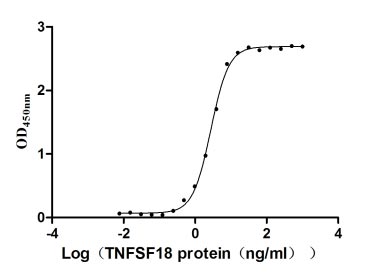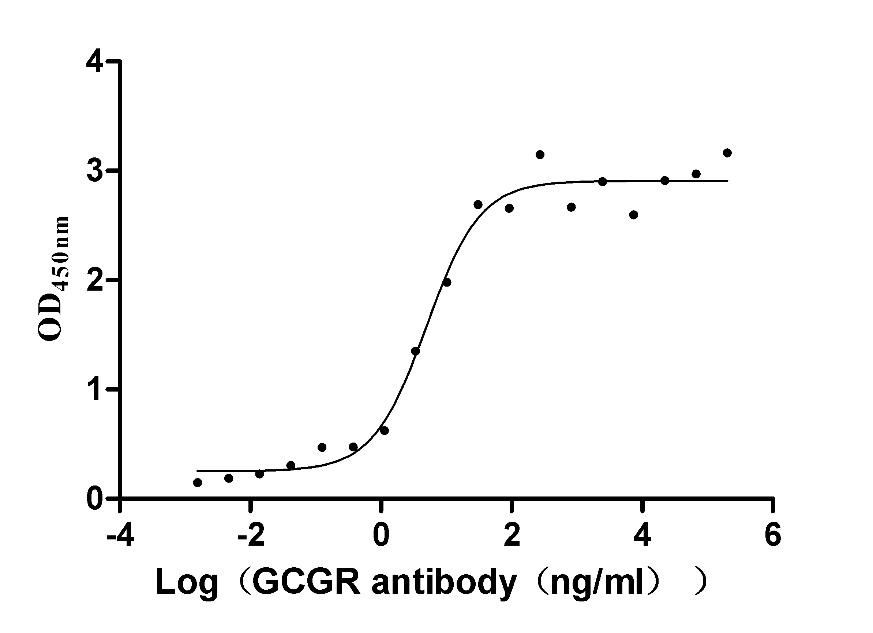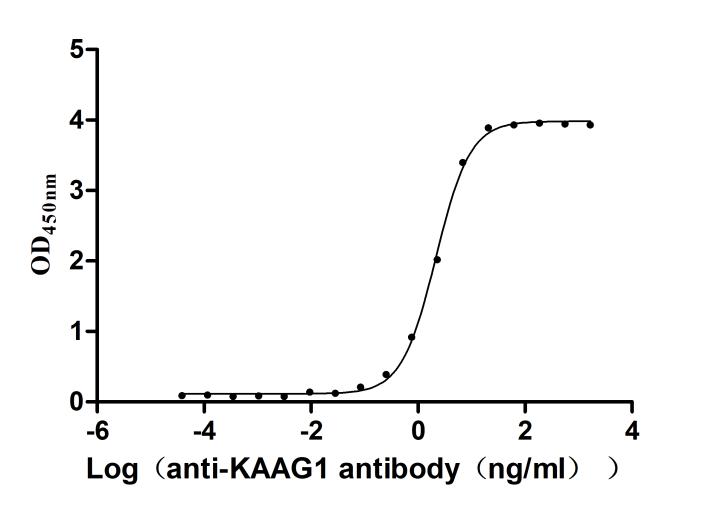Recombinant Human 5-hydroxytryptamine receptor 4 (HTR4), partial
-
货号:CSB-YP622677HU1
-
规格:
-
来源:Yeast
-
其他:
-
货号:CSB-EP622677HU1
-
规格:
-
来源:E.coli
-
其他:
-
货号:CSB-EP622677HU1-B
-
规格:
-
来源:E.coli
-
共轭:Avi-tag Biotinylated
E. coli biotin ligase (BirA) is highly specific in covalently attaching biotin to the 15 amino acid AviTag peptide. This recombinant protein was biotinylated in vivo by AviTag-BirA technology, which method is BriA catalyzes amide linkage between the biotin and the specific lysine of the AviTag.
-
其他:
-
货号:CSB-BP622677HU1
-
规格:
-
来源:Baculovirus
-
其他:
-
货号:CSB-MP622677HU1
-
规格:
-
来源:Mammalian cell
-
其他:
产品详情
-
纯度:>85% (SDS-PAGE)
-
基因名:
-
Uniprot No.:
-
别名:HTR4; 5-hydroxytryptamine receptor 4; 5-HT-4; 5-HT4; Serotonin receptor 4
-
种属:Homo sapiens (Human)
-
蛋白长度:Partial
-
蛋白标签:Tag type will be determined during the manufacturing process.
The tag type will be determined during production process. If you have specified tag type, please tell us and we will develop the specified tag preferentially. -
产品提供形式:Lyophilized powder
Note: We will preferentially ship the format that we have in stock, however, if you have any special requirement for the format, please remark your requirement when placing the order, we will prepare according to your demand. -
复溶:We recommend that this vial be briefly centrifuged prior to opening to bring the contents to the bottom. Please reconstitute protein in deionized sterile water to a concentration of 0.1-1.0 mg/mL.We recommend to add 5-50% of glycerol (final concentration) and aliquot for long-term storage at -20℃/-80℃. Our default final concentration of glycerol is 50%. Customers could use it as reference.
-
储存条件:Store at -20°C/-80°C upon receipt, aliquoting is necessary for mutiple use. Avoid repeated freeze-thaw cycles.
-
保质期:The shelf life is related to many factors, storage state, buffer ingredients, storage temperature and the stability of the protein itself.
Generally, the shelf life of liquid form is 6 months at -20°C/-80°C. The shelf life of lyophilized form is 12 months at -20°C/-80°C. -
货期:Delivery time may differ from different purchasing way or location, please kindly consult your local distributors for specific delivery time.Note: All of our proteins are default shipped with normal blue ice packs, if you request to ship with dry ice, please communicate with us in advance and extra fees will be charged.
-
注意事项:Repeated freezing and thawing is not recommended. Store working aliquots at 4°C for up to one week.
-
Datasheet :Please contact us to get it.
相关产品
靶点详情
-
功能:This is one of the several different receptors for 5-hydroxytryptamine (serotonin), a biogenic hormone that functions as a neurotransmitter, a hormone, and a mitogen. The activity of this receptor is mediated by G proteins that stimulate adenylate cyclase.
-
基因功能参考文献:
- found that testosterone, but not estradiol, correlated negatively with global 5-HT4R levels suggesting that men with high levels of testosterone have higher cerebral serotonergic tonus. PMID: 28426945
- l-Lysine significantly reduced the surge of plasma aldosterone induced by metoclopramide indicating that l-Lysine is able to efficiently antagonize the adrenal 5-HT4 receptors in vivo. PMID: 28103616
- Acute administration of 5-hydroxytryptamine4 (5-HT4) receptor agonist, mosapride or esophageal infusion of the transient receptor potential vanilloid receptor-1 (TRPV1) agonist capsaicin promotes secondary peristalsis.Esophageal infusion with capsaicin-containing red pepper sauce suspension does create greater mechanosensitivity as measured by secondary peristalsis than 5-HT4 receptor agonist mosapride PMID: 27438088
- Findings replicate our previous observation of a negative association between 5-HT 4R binding and memory performance in an independent cohort and provide novel evidence linking 5-HT 4R binding, as a biomarker for synaptic 5-HT levels, to the mnestic processing of positive and neutral word stimuli in healthy humans PMID: 28413715
- Results of this study indicated that HTR4 signaling upregulated ERbeta expression in hormone-naive prostate cancer and could impact on biological processes in hormone-naive prostate cancer. PMID: 28195088
- Data suggest that the 5-HT4 receptor is involved in the neurobiological mechanism underlying familial risk for depression, and that lower striatal 5-HT4 receptor binding is associated with increased risk for developing major depression disorder PMID: 25522384
- PDE3A1 and PDE4D3 are integrated into complexes that contain the 5-HT4(b) receptor and may thereby regulate 5-HT4(b) receptor-mediated signaling. PMID: 25101859
- The findings of altered lung function and increased AHR in Htr4-null mice support a causal relationship between genetic variation in HTR4 and pulmonary function identified in human genome-wide association studies. PMID: 25342126
- This study demonistrated that 5-hydroxytryptamine (serotonin) receptor 4 regulate memory. PMID: 25622143
- ADAM19 rs1422795 and HTR4 rs11168048 are associated with pulmonary function. PMID: 24951661
- This is the first transgenic model to study human 5-HTreceptor in the atrium ex vivo or in vivo. PMID: 23307014
- Stimulation of central 5-HT4 receptors is potentially disease-modifying in a transgenic mouse model of Alzheimer's disease. PMID: 23474291
- Taken together, these data suggest a role for HTR4 in lung development, which may at least in part explain the genetic association with lung function. PMID: 23890215
- Our results suggest that HTR4 polymorphisms may not play a major role in the susceptibility for suicidal behavior in subjects with schizophrenia. PMID: 22842674
- These results suggest a prominent role of 5-HT(4)R in promoting angiogenesis. PMID: 22903372
- Results suggest an important role for the CHRNA5/3 region as a genetic risk factor for airflow obstruction independent of smoking and implicate the HTR4 gene in the etiology of airflow obstruction. PMID: 22837378
- Our findings are consistent with a model wherein the 5-HTTLPR S allele is associated with relatively increased serotonin levels. PMID: 22584237
- These findings suggest that the 5-HT(4)R is critically involved in reward circuits that regulate people's food intake PMID: 22709820
- Mucosal 5-HT(4) receptor activation can mediate the prokinetic and antinociceptive actions of 5-HT(4)R agonists. PMID: 22226658
- The occurrence of heterogeneous post-translational modifications (PTMs) on transgenic proteins, as well as the complications that non-native PTMs can cause, highlight the characterization of both endogenous and heterologous protein targets. PMID: 22145929
- 5-HT4 receptor binding was a positively correlated to amyloid beta (A4) burden and negatively to MMSE score of the Alzheimer disease patients PMID: 21673407
- HTR4 polymorphism associated with COPD risk and lung function decline PMID: 21965014
- SNP and haplotypes of the HTR4 gene were associated with the asthma phenotype and genetic variation of HTR4 may affect susceptibility to the development of asthma. PMID: 21382128
- The relatively stable HT4 5- receptor binding with aging contrasts others in subtypes of receptors, which generally decrease with aging. PMID: 21364600
- This study demonistrated that 5-HT4 receptor is present in the human thalamus prenatally. PMID: 20538346
- No association was found in the family sample betweewn HTR4 and schizophrenia. PMID: 19892407
- Data show expression of TNS1, GSTCD, AGER, HTR4 and THSD4 in lung tissue and indicate potential targets for interventions to alleviate respiratory disease. PMID: 20010834
- Computational model of the complex between GR113808 and the 5-HT4 receptor guided by site-directed mutagenesis and the crystal structure of rhodopsin. PMID: 11989623
- The polymorphisms associated with mood disorder were located within the region that encodes the divergent C-terminal tails of the 5-HT(4) receptor. PMID: 12399948
- report the activation of the extracellular signal-regulated kinases (ERKs) 1 and 2 (p44 and p42 MAP kinase) through the human serotonin receptors 5-HT(4(b)) and 5-HT(7(a)) PMID: 12446729
- results show an overexpression of the 5-HT4 receptor in cisapride-responsive ACTH-independent bilateral macronodular adrenal hyperplasia PMID: 12519861
- A highly significant association between schizophrenia and haplotype A-T (OR = 0.13 [0.03-0.58]) was detected. PMID: 12898568
- Our results suggest a complex regulation of the h5-HT4 receptor gene expression involving distinct promoters and non-coding exons. PMID: 15575821
- secretion of the non-amyloidogenic form of amyloid precursor protein, sAPPalpha induced by the 5-HT4(e) receptor isoform was not due to a general boost of the constitutive secretory pathway but rather to its specific effect on alpha-secretase activity PMID: 15710402
- inhibition of Na+/H+ exchange activity by serotonin is mediated by 5-HT4 receptors in Caco-2 cells PMID: 15825078
- coexpression of h5-HT4R and beta2-adrenergic receptor (beta2AR) led to their heterodimerization PMID: 15896782
- the uncoupling and endocytosis of 5-HT4R require different GRK2 concentrations and involve distinct molecular events PMID: 15919661
- development of an adenovirus expression system to examine the properties of two human 5-HT4 receptor splice variants, h5-HT4(b) and h5-HT4(d), expressed in adult cardiomyocytes devoid of native 5-HT4 receptors PMID: 15950987
- These findings provide the first evidence of differential internalization between the two splice variants, 5-HT(4a) and 5-HT(4b) receptors. PMID: 16209130
- We show overexpression & different splicing of 5-HT4 receptor in aldosterone-producing adenoma tissues in comparison with normal adrenocortical tissue.Isoforms (a) & (b) were not expressed in any APA but were present in majority of normal adrenal cortex. PMID: 16322401
- These results suggest that the HTR4 gene may play a role in the genetic predisposition to ADHD. PMID: 16563621
- Data show that 5-HT(4) receptor stimulation in primary neurons produced a potent but transient activation of the ERK pathway that is dependent on Src tyrosine kinase but totally independent of beta-arrestin. PMID: 17377064
- We show that disulfide bridges between Cys112 and Cys145 located within transmembrane domain 3 and transmembrane domain 4, respectively, are of critical importance for 5-HT(4)R dimer formation. PMID: 17379184
- Our results indicate that h5-HT(4(b)) is the dominant cardiac isoform of human 5-HT(4) receptors and its expression is increased in CAF. PMID: 17418812
- Functional activiy of 5-HT4 receptors was studied in children with congenital heart disease. PMID: 17603679
- In this review, the pathways regulating either beta- or gamma-secretase may be differentially controlled by 5-HT4 receptor isoforms. PMID: 18322379
- In failing human ventricle, 5-HT(4) receptor-mediated positive inotropic response was regulated by PDEs in a manner similar to that in postinfarction rat hearts;5-HT, PDE3 and PDE4 may have pathophysiological functions in heart failure. PMID: 18846035
- 5-HT4 expression is lower in heart ventricle vs. atrium. Isoform expression in atrium and ventricle is similar. There is a parallel increase of cAMP and in the phosphorylation state of regulatory proteins following stimulation with 5-HT in the atrium. PMID: 19002436
- The human 5HT4 receptor, when placed under the influence of the mouse opsin promoter and an opsin rod outer segment (ROS) targeting sequence, localized to ROS of transgenic mouse retina. PMID: 19053287
- This paper presents an analysis of the SH3TC2 promoter after identifying a read-through transcript of the SH3TC2 and HTR4 loci. Available data suggests HTR4 is a separate locus with its own promoter, and not the product of a bi-cistronic transcript. PMID: 11716477
显示更多
收起更多
-
亚细胞定位:Cell membrane; Multi-pass membrane protein. Endosome.
-
蛋白家族:G-protein coupled receptor 1 family
-
组织特异性:Isoform 5-HT4(A) is expressed in ileum, brain, and atrium, but not in the ventricle.
-
数据库链接:
HGNC: 5299
OMIM: 602164
KEGG: hsa:3360
UniGene: Hs.483773
Most popular with customers
-
Recombinant Human Tumor necrosis factor ligand superfamily member 18 (TNFSF18), partial (Active)
Express system: Mammalian cell
Species: Homo sapiens (Human)
-
Recombinant Human Glucagon receptor (GCGR), partial (Active)
Express system: Mammalian cell
Species: Homo sapiens (Human)
-
Recombinant Human Epithelial discoidin domain-containing receptor 1 (DDR1), partial (Active)
Express system: Mammalian cell
Species: Homo sapiens (Human)
-
Recombinant Human Tumor-associated calcium signal transducer 2 (TACSTD2), partial (Active)
Express system: Mammalian cell
Species: Homo sapiens (Human)
-
Recombinant Human Transferrin receptor protein 1 (TFRC), partial (Active)
Express system: Mammalian cell
Species: Homo sapiens (Human)
-
Recombinant Human Interleukin-2 (IL2) (Active)
Express system: Mammalian cell
Species: Homo sapiens (Human)
-
Recombinant Human Gastric inhibitory polypeptide receptor(GIPR),partial (Active)
Express system: Mammalian cell
Species: Homo sapiens (Human)
-
Recombinant Human Kidney-associated antigen 1(KAAG1) (Active)
Express system: E.coli
Species: Homo sapiens (Human)




















